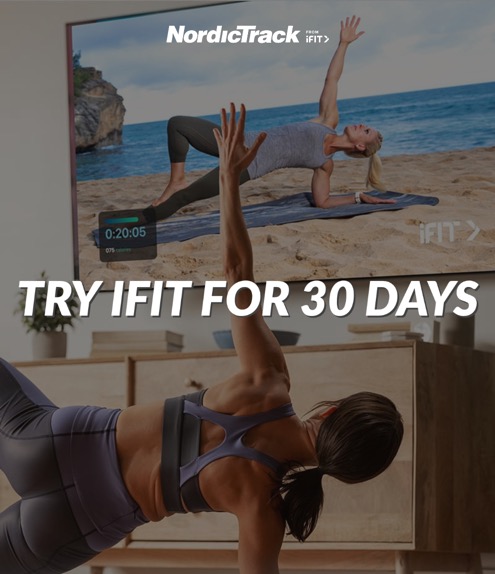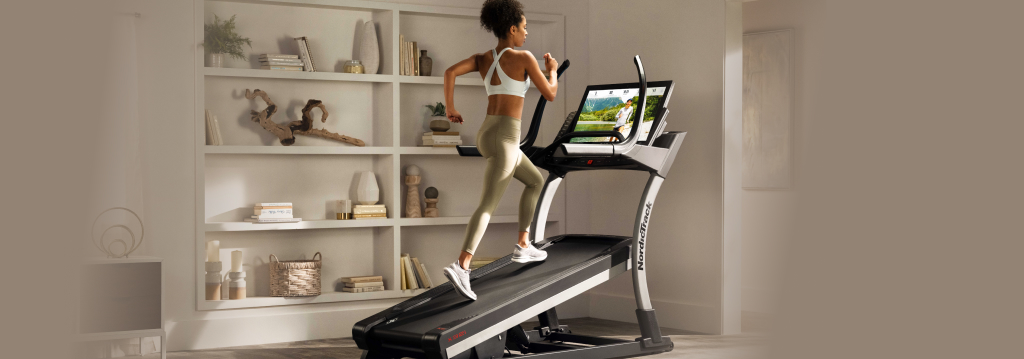
Are you wondering how to decide on the best incline treadmill?
Should you go by price?
Features?
Brand name?
Or maybe you’re early on in your search, and you’re wondering what the difference is between a standard treadmill and an incline treadmill.
This incline treadmill guide is for you no matter which group you fall under.
In it, we’re covering:
- What is an incline treadmill?
- Why choose an incline treadmill?
- What factors should you consider when choosing an incline treadmill?
- The best incline treadmills to consider
If you’re short on time, consider these key takeaways:
- An incline treadmill is one where you can significantly raise the angle of the treadmill deck to simulate walking or running up a hill.
- Some great health benefits come with using an incline treadmill, including increased intensity and calorie burn, engaging your muscles at varying levels, providing a challenging workout, adding variety to your workouts, and improving your endurance.
- NordicTrack offers three different incline treadmill series depending on your fitness level and budget.
Read on to learn all about incline treadmills and how to decide on the best incline treadmill to meet your fitness goals.
What is an Incline Treadmill?
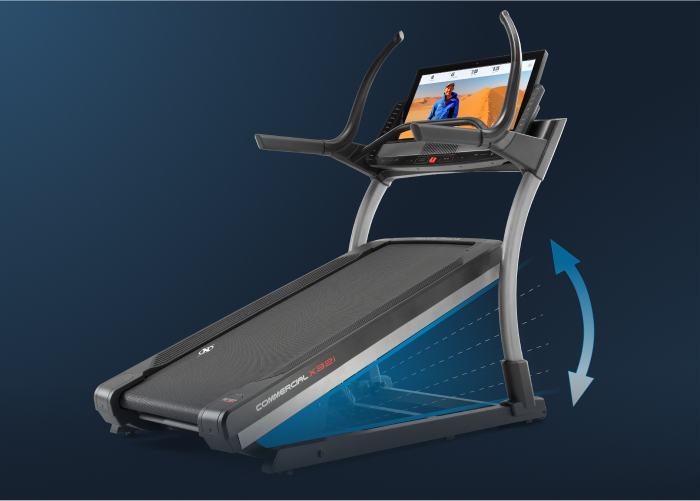
As the name suggests, an incline treadmill is a type of treadmill that lets you significantly adjust the angle or incline of the running surface.
Standard treadmills can adjust the incline anywhere from 1% to 15%, depending on the model.
But, with an incline treadmill, also sometimes referred to as an incline trainer, you can raise the angle of the treadmill deck much more significantly to simulate walking or running up a hill.
For example, the NordicTrack high incline treadmills can reach up to a 40% incline.
In this article, we’re diving into true incline treadmills, including those reaching up to 40% incline.
If you’re looking for a standard treadmill with up to a 12% incline, check out that link to see plenty of great options.
And, if you’re leaning towards that higher incline, you may be wondering:
Why Choose an Incline Treadmill? The Top 5 Benefits of an Incline Treadmill to Consider
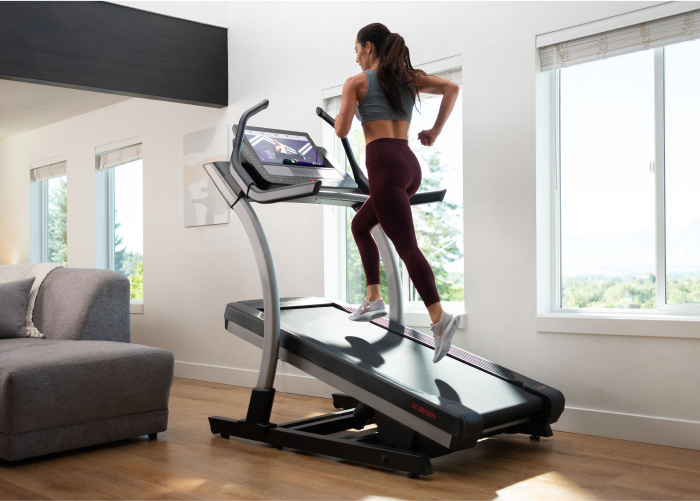
When considering a standard treadmill vs. an incline treadmill, you may be wondering if there are any benefits to going with the latter vs. the former.
You may be surprised to learn that adding that incline has some positive perks.
Here are some of the top benefits of incline treadmills:
1. Increases Intensity & Calorie Burn
Harvard Health says, “An incline setting generates more muscle activity than walking on a flat surface since you work against gravity.” [1]
This extra challenge elicits a deeper muscle activation, which may help you burn more calories by adding in an incline. [2] It’s important to note that this study only looked at 0%, 5%, and 10% inclines, so more research is needed to draw firm conclusions at a higher incline.
One body of research showed that walking at a 5% incline increased metabolic cost, or the amount of energy expended, usually in calories, by 52%, while walking at a 10% incline resulted in a whopping 113% increase in calories burned. [2]
Based on those numbers, imagine the calorie burn if you upped your incline to 40%.
2. Engages Your Muscles at Varying Levels
Depending on the incline or decline, you can engage your quadriceps, glutes, hamstrings, and calves to various degrees just by adjusting the angle.
Adding a 1% incline takes your flat surface up a notch, while bumping this figure up to a 40% incline mimics an uphill climb.
Uphill climbs use different muscles and can provide a challenge while moving at slower speeds.
3. It Provides a Challenging Workout
Increasing or decreasing your incline also lets you play around with how challenging or easy your workouts are.
Adding that extra incline can be a fun way to test and improve your fitness level.
For example, bumping up your incline to 30% at three MPH will feel vastly different than walking at a 1% incline.
Keeping the surface flat offers one level of exertion while increasing the incline or decline by 30 to 40% can take your workouts to the next level.
Adjusting the incline or decline, you can play around with your workouts’ challenges.
4. Adds Variety to Your Workouts
Changing the incline or decline of your treadmill can also keep your workouts interesting.
You can challenge yourself on days you feel good by increasing the incline or decline.
And, when you’re not up for it or recovering, you can scale back to a low incline or no incline.
You can add variety throughout your workout by going up or down in intensity during your training session or by varying your incline levels throughout the week.
How you add variety to your workouts is up to you and can change as often as you’d like to meet your fitness goals.
But having the incline feature is key to being able to do that.
5. Improves Endurance
Walking or running on an incline engages different muscles than exercising on a flat surface.
Specifically, you’ll engage the posterior chain muscles, including the hamstrings, glutes, and calves, just by adding an incline.
This extra bit of challenge may help improve your endurance in these muscles as they adapt to this change in incline. [3]
Another way walking or running may improve endurance is by increasing your aerobic capacity, the maximum amount of oxygen your body uses during exercise. [4]
If you’ve ever felt winded climbing up a hill or walking up a flight of stairs, that’s your aerobic capacity kicking in.
By consistently training on an incline, you may improve and increase your aerobic capacity, improving your overall health and endurance. [5]
Incline trainers may also be great for those readers who enjoy hiking mountains and climbing to different elevations.
For example, if you want to hike Machu Picchu one day, you could train on your incline treadmill to prepare your body for the steep elevation ahead.
To learn more about the benefits of an incline treadmill, check out these articles when you’re done here:
- What is a Good Incline To Walk on a Treadmill To Lose Weight?
- 5 Reasons Why Incline Treadmills Transform Your Workouts
- How Treadmill Incline Can Help Improve Your Endurance
What Factors Should You Consider When Choosing an Incline Treadmill?
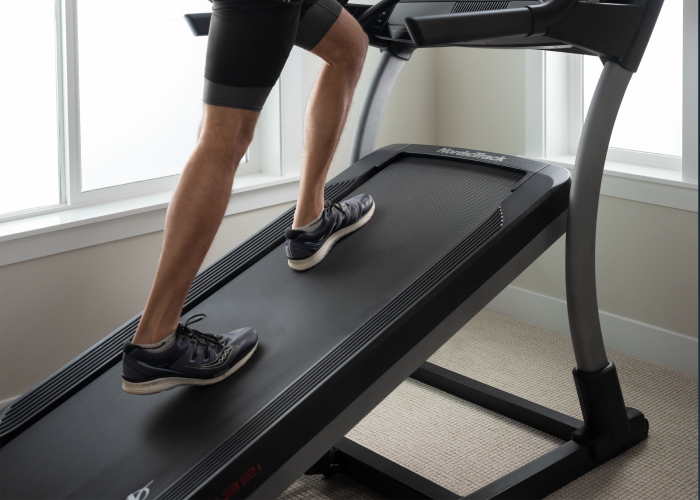
Now that you know the benefits of an incline treadmill, we’ll move into what you’ll want to consider as you browse your options online.
To start, you should answer the following:
1. How High of an Incline Do You Need?
You’ll want to consider how you plan to use your incline treadmill.
Will you walk, hike, jog, or run? Or a combination of these?
You should also think about how other people in your household may use it.
Answering these questions will help you determine how high of an incline you need.
If you’re new to using an incline treadmill, a standard treadmill that adjusts from 0% to 12% incline may be all the challenge you need right now.
But if you’ve been consistently training on an incline treadmill, you may want to opt for a higher incline, such as one that goes up a whopping 40%.
Consider your current fitness level and goals to determine how high of an incline makes sense for you before moving on.
2. How Much Space Do You Have for an Incline Treadmill?
Next, you want to consider your space for a home treadmill.
While the incline feature won’t take up any more space, true incline treadmills don’t fold up, which you’ll need to consider if you have a small space.
On top of that, you’ll want to have a certain amount of clearance space around the machine, per the user manual.
You’ll need this distance around the machine’s front, back, and sides.
In addition, you’ll also want to think about the belt size to make sure it can accommodate how you plan to use the treadmill.
If you’re running or plan to use the incline feature, it pays to have a nice-sized, sturdy belt so it’s comfortable to use.
Before moving on, measure your space for a home treadmill to ensure it’ll fit nicely in your room when you find the one you like.
3. Sturdy Design
From there, you should look at the treadmill design to ensure it’s sturdy and has supportive features.
Solid and sturdy support handles are crucial since you plan to use the incline feature.
Should you need to hold on during any point of the workout, you want those supportive handles to be there and strong when you need them.
You also want the treadmill to have a sturdy base design so that you can comfortably use the incline feature.
In addition, having extra support and a cushioned belt and base are other must-have features to ensure your incline workouts are comfortable.
After all, you don’t want the machine shaking back and forth while running or hiking up an incline.
Lastly, as mentioned in the previous section, having a good-sized, supportive treadmill belt is also key to keeping you comfortable and safe during your workout.
Ensure the incline treadmills you’re looking at have these supportive features.
4. Other Must-Have Features
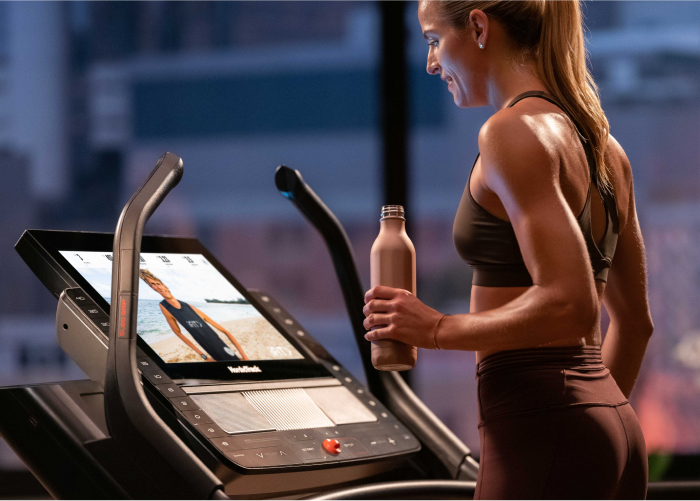
From there, you can think about the other features that appeal to you.
For example, having OneTouch® controls lets you quickly and easily change your speed or incline with one or two button taps.
This feature is great if you’re practicing interval training (HIIT) or plan to run or move faster on your treadmill.
You can also choose treadmills that connect to iFIT, a paid subscription service that allows you to follow done-for-you workouts from top trainers from around the globe.
They’ll handle the speed and incline for you, and your machine automatically adjusts to the pre-set workout they’ve laid out.
This feature is great if you want to show up and press play and not have to plan out every workout you do.
Another feature on NordicTrack incline treadmills is ActivePulse™, which gives you a feedback loop that measures your heart rate against the treadmill’s speed and incline. Then, it automatically adjusts the resistance level to keep you in your target heart rate zone.
Other features to consider are whether or not the treadmill folds up when not in use, how easy or hard it is to fold the treadmill, whether it connects to Bluetooth® headphones, and whether or not it tracks your workouts.
Think about the features that might matter the most to you, jot these down, and make sure the treadmills you’re eyeing come equipped with these features.
5. The Weight Limit of the Machine
Next, it’s essential to consider the weight limit of the incline treadmill you’re looking at.
Cheaper-priced treadmills often have a much lower user weight limit than high-quality ones.
Good incline treadmills usually reach 300 pounds in their maximum user capacity.
6. Your Budget
Knowing how much you want to spend on an incline treadmill is also good.
If you’re eyeing up a more expensive model but don’t have the cash on hand, you can always use treadmill financing to make smaller payments over time.
This can help you invest in a high-quality incline treadmill without shelling out the total amount upfront.
7. The Warranty
Lastly, don’t forget to check out the warranty that comes with any incline treadmills you’re checking out.
You don’t want to find out later on that the treadmill doesn’t offer much coverage, and it’s too late.
All NordicTrack treadmills come with the following warranty:
- 10-year frame warranty
- 2-year parts warranty
- 1-year labor warranty
You can also add extended warranties and maintenance plans for an additional charge.
The 3-year extended warranty extends your manufacturer warranty by three years and includes the following:
- 10-year frame warranty
- 5-year parts warranty
- 4-year labor warranty
The Best Incline Treadmill is the NordicTrack Commercial X32i or Commercial X22i
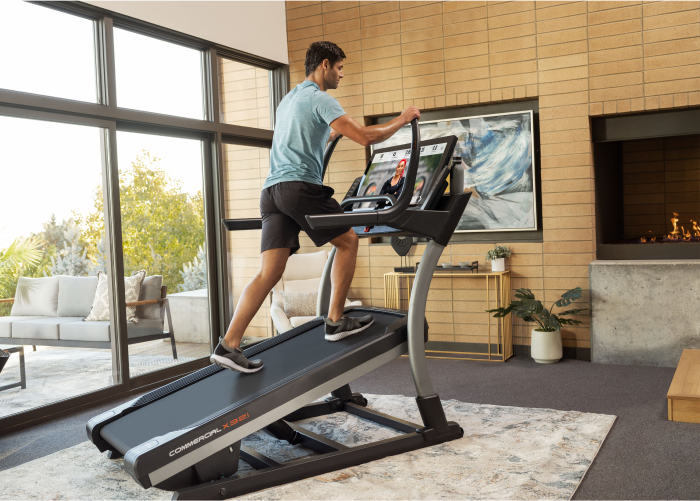
With all that covered, we can move on to finding the best incline treadmill.
The winner for that title goes to:
The NordicTrack Incline Series High Incline Treadmills
If you want a high-incline treadmill that helps you reach new heights, check out the NordicTrack Incline Series.
They reach a whopping 40% incline and decline to -6%.
So you can climb mountains, walk or run down as if you’re on a hill, reach new heights, and challenge yourself even more.
The NordicTrack Incline Series treadmills also come equipped with the same great features as the Commercial Series, including:
- OneTouch® Controls (as mentioned above, this feature lets you quickly and easily adjust your incline grade and speed by tapping one or two numbers. This is great for interval training when you need to quickly switch from high to low periods of exertion and vice versa.)
- Hands-free SmartAdjust™ Technology (Your speed and incline automatically adjust with the iFIT trainer you’re following on the screen. Your treadmill will store any adjustments you make mid-workout and use these changes for future workouts. Only available with an active iFIT subscription)
- Tilt and pivot smart HD touchscreen
- Built-in AutoBreeze™ fans to keep you cool while you work out
- Bluetooth® headphone and heart rate monitor compatibility
- ActivePulse™ (This feature gives you a real-time feedback loop that measures your heart rate against your treadmill’s speed and incline, automatically adjusting the resistance level to keep you in your target heart rate zones. Only available with an active iFIT subscription.)
- Google Maps™ integration so you can immerse yourself anywhere in the world right from your home (only available with an active iFIT membership)
- Stat tracking to show you in-depth personal workout stats
The Incline Series treadmills from NordicTrack also have a:
- 300-pound weight capacity
- 70” L x 39” W x 72.5” H Footprint
One thing to note with this high-incline treadmill is that it does not fold up.
So, if you need our SpaceSaver® design and EasyLift™ Assist, you may be better off with one of our other treadmills. You can learn more about those features and the treadmills that have them by visiting that link now.
The bottom line
We hope this incline treadmill guide has helped you narrow your selection if you’re deciding on which one to buy.
If you do decide to go with the incline treadmill we featured in this article, you’ll likely be pleasantly surprised by just how fun of a challenge that extra incline is.
You might even find that you wished you bought one sooner.
So go on and experience the benefits of an incline treadmill and find your perfect fit today.
References:
- https://www.health.harvard.edu/staying-healthy/get-smart-about-treadmills
- Silder, A., Besier, T., & Delp, S. L. (2012). Predicting the Metabolic Cost of Incline Walking from Muscle Activity and Walking Mechanics. Journal of Biomechanics, 45(10), 1842. https://doi.org/10.1016/j.jbiomech.2012.03.032
- Padulo, J., Powell, D., Milia, R., & Ardigò, L. P. (2012). A Paradigm of Uphill Running. PLoS ONE, 8(7). https://doi.org/10.1371/journal.pone.0069006
- https://willamette.edu/undergraduate/exsci/laboratory-testing/services/aerobic-capacity/index.html
- Silveira Mendes, T. A., Nunes, S., Rodrigues Cardoso, D. C., Silva, C., & Ribeiro, T. S. (2018). Effects of inclined treadmill training on functional and cardiovascular parameters of stroke patients: Study protocol for a randomized controlled trial. Trials, 20. https://doi.org/10.1186/s13063-019-3298-3
Disclaimer: This blog post is not intended to replace the advice of a medical professional. The above information should not be used to diagnose, treat, or prevent any disease or medical condition. Please consult your doctor before making any changes to your diet, sleep methods, daily activity, or fitness routine. iFIT assumes no responsibility for any personal injury or damage sustained by any recommendations, opinions, or advice given in this article. Always follow the safety precautions included in the owner’s manual of your fitness equipment.


